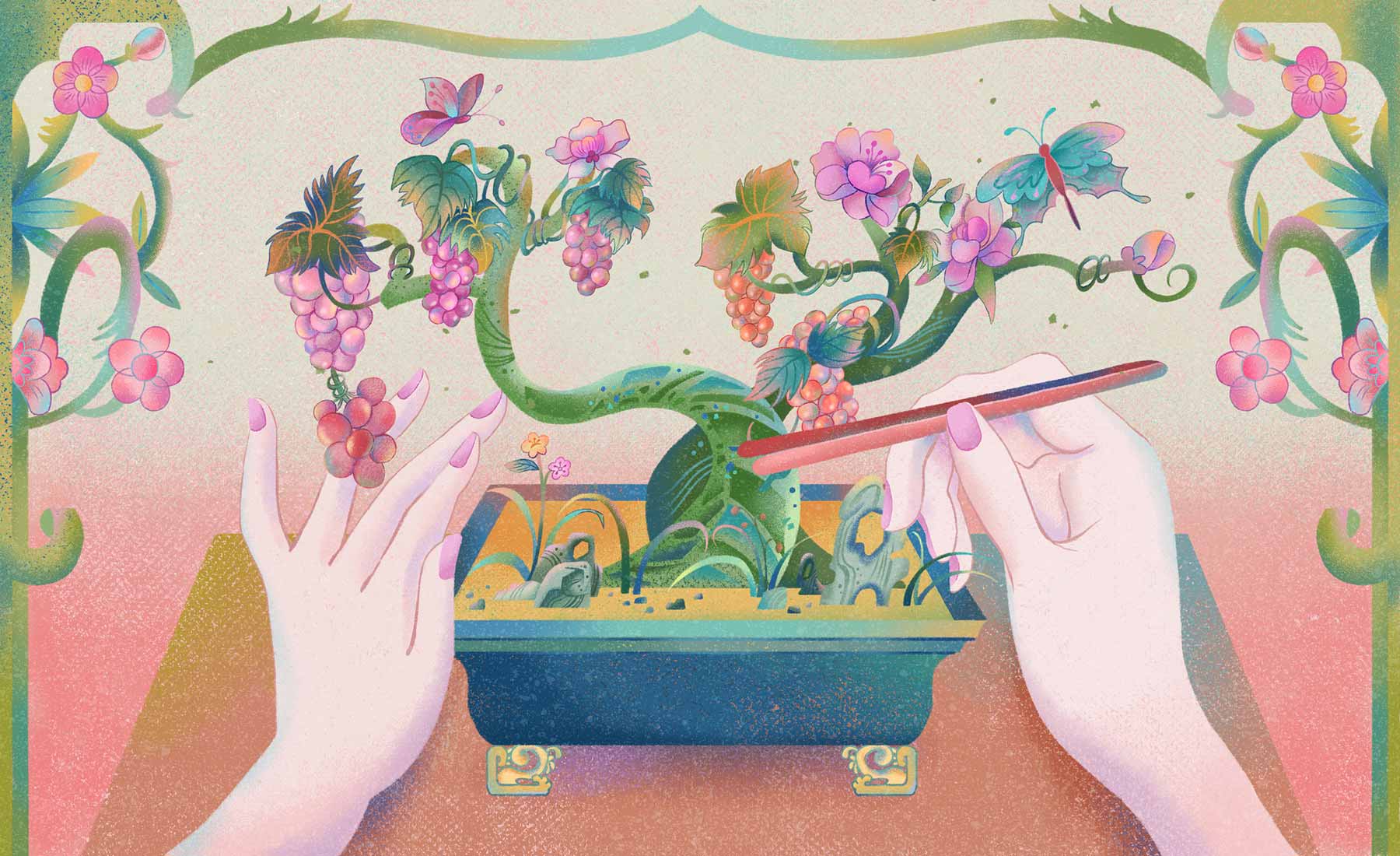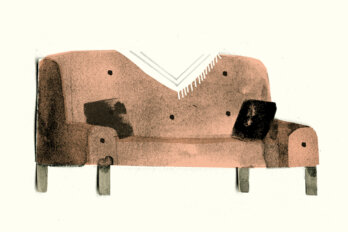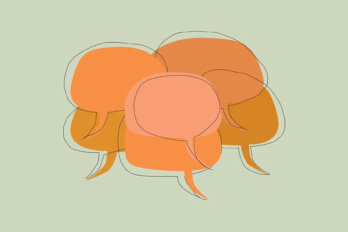When I was growing up, my parents never seemed to take care of themselves. I remember rushing to Toronto Western Hospital in a cab with my mom in the early hours of one particular morning after witnessing her having a panic attack. This happened sometime in 2012, when home was just me and her—my older sibling had moved abroad, and my dad was working in a different province. Hours later, as my mom lay in a hospital bed, clutching a potassium supplement and a banana, I was relieved that she was still alive, but I was taken aback that she seemed more concerned about me missing class than her own well-being.
As a young girl, I shared a bedroom with my parents. My family immigrated from Hong Kong to Canada when I was nine, and for a period of time that seems both distant and familiar, we struggled financially. Sharing a bedroom with the people who raised me felt like living in a fishbowl; I yearned to recover a sense of privacy and the ability to carve out my own identity, which seemed lost in limbo.
Even on days when I felt homesick for life back in Hong Kong, I felt ashamed that I wanted to ask for more. In part, this was because I didn’t want to seem ungrateful—we had just moved to a new country, and my aunts had opened their home to my family. Having a roof over our heads was a blessing, even if I chafed at it.
In my culture, there’s an unspoken rule that sometimes it’s better to remain silent about your pain in order to protect the feelings of others. For a long time, I struggled to articulate how this philosophy shaped my identity. To me, the power of this philosophy is best captured by the values traditionally associated with it, like gwaan hai (關係), loosely translated as relationships that carry mutual obligations and benefits in order to achieve wo haai (和諧), or a sense of harmony. There’s also the art of giving and saving face, or min zi (面子), which I understand to be a dynamic process made up of acts of mutual respect, like giving credit to others for something you want to brag about yourself or taking a moment to consider who will be impacted if you express strong feelings like anger or shame. Admittedly, I don’t think I lived up to these values growing up. But they seemed to endure at the back of my mind, like habits we become accustomed to without really being aware of.
I guess these are the same values that held my dad back from sharing his mental health experiences with me. I remember finding a drawing he had faxed to my mom after a gruelling day at a job that required him to spend weeks at a time away from us. Hunched over a desk and piles of papers was a man whose black curly hair and moustache resembled his, and he looked exhausted and defeated. Just as no words accompanied that drawing, no words were ever exchanged between us about it.
Between my physical circumstances and my cultural upbringing, I began to tie my identity to the selflessness I grew up with. My childhood led me to internalize the idea that I should always consider the feelings of others before my own. By the time I became an adult, I was hungry for a sense of self that wasn’t tied to others—so I began to embrace a radical form of self-care. After starting therapy for the first time, I adopted a number of self-care techniques and quickly established a habit of daily meditation and regular exercise. Learning to intentionally care for myself was intoxicating. I noticed a calmer version of me emerge. I felt rested, better equipped to practise boundaries, and more able to detach myself from the wave of emotions that led me to therapy in the first place. But focusing on myself soon came at the expense of my ability to focus on others.
As I delved deeper into my own self-care journey, I found myself disconnected from my family as well as the community I was raised in. I started calling my parents and sibling, who had all moved to different parts of the world, less often. When we spoke, our interactions involved a predictable sequence of small talk and uneasy silences. I still wonder how much of this was tied to a fear that any reminder of the sacrifices my family had made in my childhood would sabotage my self-care efforts, sending me back into a familiar spiral of guilt.
When I explored topics like racism in therapy sessions, I’d focus on the way they had personally impacted me as opposed to those around me. I often encountered racism in my early twenties while working as an assistant at a hotel. I recall that a manager from a different department once asked me to assist an Asian guest because they only spoke Korean. Another time, I remember a senior executive uttered “Love you long time” as I left a meeting room. While therapy provided an opportunity to unpack interactions like these, I rarely considered how other Asian people experienced racism. In fact, I hardly ever stopped to recognize how the privileges I enjoyed shielded me from the worst of it.
On March 16, 2021, a man went on a shooting spree at three spas in metro Atlanta. He killed eight people, including six Asian women. This was one of the deadliest incidents in a spate of violence against Asian people in the United States. Reports of anti-Asian hate crimes had surged since the beginning of the pandemic.
Until these shootings, I hadn’t deeply considered who in my community was being cared for and who was equipped to care for themselves. As I immersed myself in self-care practices, people across the Asian diaspora in Canada and the US were being assaulted and killed. According to Statistics Canada, police-reported hate crimes against East and Southeast Asian Canadians quadrupled in 2020 compared to the previous year. A few days after COVID-19 was officially declared a pandemic, a ninety-two-year-old man was reportedly subjected to a racist tirade before being shoved to the ground outside a convenience store in East Vancouver. An eighty-nine-year-old Asian American woman in New York City was allegedly lit on fire by two thirteen-year-old boys later that summer. Between March 2020 and December 2021 in the United States, over a quarter of hate incidents against Asian elders, who symbolize strength and inspire reverence in my culture, involved physical assault, according to a report from Stop AAPI (Asian American and Pacific Islander) Hate and the AARP (formerly the American Association of Retired Persons). I didn’t know how to square my new-found liberation with what was happening to Asian communities in Canada and the US. I felt guilty.
I became particularly invested in the story of Hyun Jung Kim, who is also identified by her married name Grant, one of the victims of the Atlanta spa shootings. Kim was a single mother and former elementary school teacher from South Korea who worked at the spa to support her two sons, who were both in their early twenties when the shootings happened. After she was killed, Kim’s sons struggled to pay for living expenses. One of them started a GoFundMe campaign, pleading for help from the public, and eventually raised an astonishing $2.9 million (US).
Kim’s death and its aftermath inspired me to join friends and family who were already making efforts to mobilize against anti-Asian and racial violence. I listened to their calls to donate to various GoFundMe pages as well as organizations that serve our community’s most vulnerable, including Butterfly, a support network for Asian and migrant sex workers, and Asian Americans Advancing Justice – Atlanta, which provides legal services to low-income communities in Georgia. When I visited GoFundMe pages for victims of violence like Woom Sing Tse, a seventy-one-year-old who was fatally shot in Chicago in December 2021, I tried to learn about their lives and the people they had left behind—many were immigrants, like my parents, who had started over in new countries in order to better provide for their families. I was saddened by the likelihood that some had suffered those years in silence, without access to the mental health resources people like me are afforded today.
The opportunity to practise community care had a grounding effect. Since last May, I’ve been volunteering a few days a week with an organization that provides one-on-one peer support to those struggling with mental health. Volunteering showed me my time and privilege could be channelled toward supporting a new generation, especially given how mental health services are underused by Asian people in Canada and the US. This felt like the perfect middle path between the self-sacrifice that had defined my childhood and the self-care of my young adulthood.
One day, as I scrolled through Twitter, I came across a quote from writer Nakita Valerio that clarified the shift in my perspective. “Shouting ‘self-care’ at people who actually need ‘community care’ is how we fail people.” At last, I thought, an insight that captured why self-care on its own had lost its appeal as my community was under attack. In a piece elaborating on her post, Valerio described community care as a “commitment to contributing in a way that leverages one’s relative privilege while balancing one’s needs.” I believe this definition captures any type of care one can provide—be it time, energy, money, or resources—to support and benefit others, including those that might be outside our reach. Ultimately, what I drew from Valerio’s words was that, rather than being mutually exclusive, caring for one’s community and for oneself can happen at the same time.
In the 1960s and ’70s, the Black Panther Party radicalized their definition of care by pioneering community initiatives like free medical clinics and breakfast programs for people in need. Valerio’s concept of community care hearkens back to the Black Panther Party’s philosophy: lifting up those in your community who are struggling can in turn lift you up. And it has tangible, material benefits—look at what happened with Kim’s family.
Just as community care benefits others, it also benefits the self. When the COVID-19 pandemic was announced, two things claimed much of my mental real estate: the increasing toll that isolation started to take on me and the rise of anti-Asian racism toward my community. While self-care helped me care for myself in spite of those circumstances, community care moved me to tackle those circumstances directly, whether through donating and volunteering or simply by lending an ear to someone who needed to be heard. With this came the understanding that caring for other people also allowed me to heal and thrive. More than a year into the pandemic, a colleague mailed me a book about Hong Kong after I shared my regret over not visiting my grandparents. A friend hosted group calls to provide mutual support during the pandemic surge in anti-Asian racism. My community rallied together at Nathan Phillips Square in Toronto after the Atlanta shootings.
Around the same time that my therapy came to an end, I learned that community care also means caring for my family. During one of my last sessions, I made a commitment to call my mom, who now lives in a different province, once a week. While this may seem like an unexceptional gesture, it was my way of beginning a journey toward returning the care she never gave to herself. Our conversations mostly revolve around a set of rotating questions—“Have you eaten yet?” or “Are you getting enough rest?”—but this time around, it’s me asking. At a time when I thought I needed self-care most, the unexpected move toward community care bridged the gap between myself and others, bringing peace to an inner struggle that my identity has been anchored in for most of my life.





